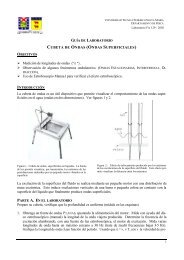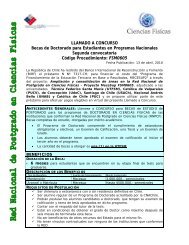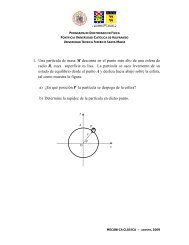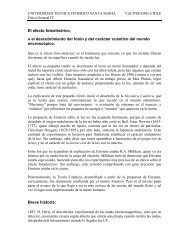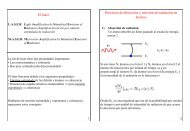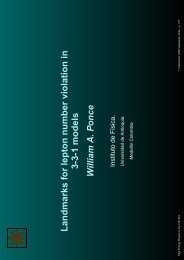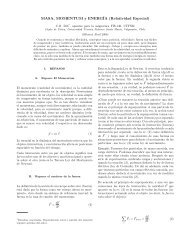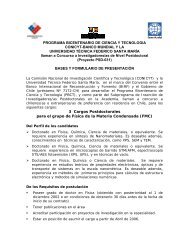Aca - Departamento de Física - Universidad Técnica Federico Santa ...
Aca - Departamento de Física - Universidad Técnica Federico Santa ...
Aca - Departamento de Física - Universidad Técnica Federico Santa ...
Create successful ePaper yourself
Turn your PDF publications into a flip-book with our unique Google optimized e-Paper software.
V Encuentro Sud Americano <strong>de</strong> Colisiones Inelásticas en la Materia<br />
Chemical Characterization of Fish-Otoliths using Micro-PIXE<br />
Stori, E. M. 1 , Dias, J. F. 1 , Favero, J. M. 2 , Dias, J. F. 2<br />
1 Laboratório <strong>de</strong> Implantação Iônica – Instituto <strong>de</strong> <strong>Física</strong>, Universida<strong>de</strong> Fe<strong>de</strong>ral do Rio Gran<strong>de</strong> do Sul, Av. Bento<br />
Gonçalves 9500, Porto Alegre, RS , Brasil<br />
2 Instituto <strong>de</strong> Oceanografia – Universida<strong>de</strong> Estadual <strong>de</strong> São Paulo – São Paulo, SP, Brasil<br />
email address corresponding author: elistori@gmail.com<br />
Fishes contain a group of three pairs of<br />
bone structures in their ear that are responsible<br />
for hearing and equilibrium. These structures<br />
grow in layers that look like rings if<br />
sectioned (figure 1). [1]<br />
of interest and its position in the otolith.<br />
[5][6]<br />
The knowledge of the trace elements<br />
present in different rings would allow to establish<br />
a relation between different places the<br />
fish have lived and the stages of its life.<br />
Figure 2 shows calcium maps of a juvenile<br />
fish otolith, in which can be observed<br />
the growth rings through the difference of<br />
intensity of the calcium signal.<br />
Figure 1. Sectioned otolith showing growth rings [2]<br />
There are very well <strong>de</strong>veloped studies<br />
that relate the rings in the otoliths with the<br />
fishes’ age. While in adult’s otoliths the rings<br />
may represent years of age, in juvenile fishes<br />
and larvae the rings represent days. [1]<br />
Moreover, the otoliths may give information<br />
of fish migration pattern or their origin<br />
by <strong>de</strong>termining the trace elements contained<br />
in them. [3][4]<br />
The micro-PIXE technique (micro-<br />
Particle Induced X-Ray Emission) is not<br />
regularly used to <strong>de</strong>termine trace elements in<br />
otoliths. Its advantages inclu<strong>de</strong> the non<strong>de</strong>structive<br />
character of the technique, and<br />
the possibility of a spacial characterization of<br />
the elements, enabling a more accurate analysis<br />
of the relation between the trace element<br />
(a)<br />
(b)<br />
Figure 2. Calcium maps of a juvenile fish otolith (a)<br />
the entire otolith and (b) a more <strong>de</strong>tailed map of the<br />
central region of the otolith.<br />
20 Valparaíso, Chile



